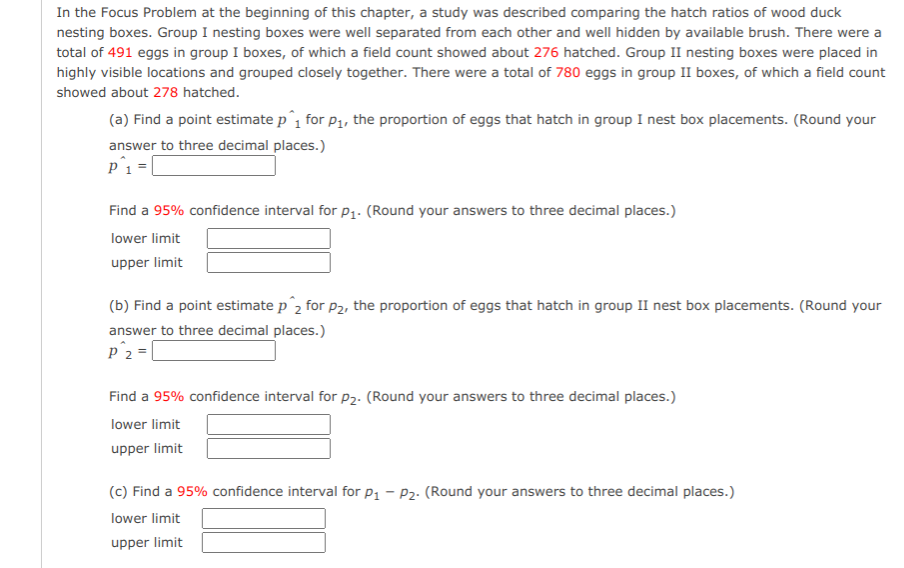In the Focus Problem at the beginning of this chapter, a study was described comparing the hatch ratios of wood duck nesting boxes. Group I nesting boxes were well separated from each other and well hidden by available brush. There were a total of 491 eggs in group I boxes, of which a field count showed about 276 hatched. Group II nesting boxes were placed in highly visible locations and grouped closely together. There were a total of 780 eggs in group II boxes, of which a field cour showed about 278 hatched. (a) Find a point estimate p´, for p1, the proportion of eggs that hatch in group I nest box placements. (Round your answer to three decimal places.) Find a 95% confidence interval for p1. (Round your answers to three decimal places.) lower limit upper limit (b) Find a point estimate p^2 for p2, the proportion of eggs that hatch in group II nest box placements. (Round you answer to three decimal places.) P2 = Find a 95% confidence interval for p2.- (Round your answers to three decimal places.) lower limit upper limit (c) Find a 95% confidence interval for p1 - P2- (Round your answers to three decimal places.) Jower limit
In the Focus Problem at the beginning of this chapter, a study was described comparing the hatch ratios of wood duck nesting boxes. Group I nesting boxes were well separated from each other and well hidden by available brush. There were a total of 491 eggs in group I boxes, of which a field count showed about 276 hatched. Group II nesting boxes were placed in highly visible locations and grouped closely together. There were a total of 780 eggs in group II boxes, of which a field cour showed about 278 hatched. (a) Find a point estimate p´, for p1, the proportion of eggs that hatch in group I nest box placements. (Round your answer to three decimal places.) Find a 95% confidence interval for p1. (Round your answers to three decimal places.) lower limit upper limit (b) Find a point estimate p^2 for p2, the proportion of eggs that hatch in group II nest box placements. (Round you answer to three decimal places.) P2 = Find a 95% confidence interval for p2.- (Round your answers to three decimal places.) lower limit upper limit (c) Find a 95% confidence interval for p1 - P2- (Round your answers to three decimal places.) Jower limit
MATLAB: An Introduction with Applications
6th Edition
ISBN:9781119256830
Author:Amos Gilat
Publisher:Amos Gilat
Chapter1: Starting With Matlab
Section: Chapter Questions
Problem 1P
Related questions
Question
Practice Pack

Transcribed Image Text:In the Focus Problem at the beginning of this chapter, a study was described comparing the hatch ratios of wood duck
nesting boxes. Group I nesting boxes were well separated from each other and well hidden by available brush. There were a
total of 491 eggs in group I boxes, of which a field count showed about 276 hatched. Group II nesting boxes were placed in
highly visible locations and grouped closely together. There were a total of 780 eggs in group II boxes, of which a field count
showed about 278 hatched.
(a) Find a point estimate p, for p1, the proportion of eggs that hatch in group I nest box placements. (Round your
answer to three decimal places.)
p’i=
Find a 95% confidence interval for p1. (Round your answers to three decimal places.)
lower limit
upper limit
(b) Find a point estimate p'2 for p2, the proportion of eggs that hatch in group II nest box placements. (Round your
answer to three decimal places.)
Find a 95% confidence interval for p2.- (Round your answers to three decimal places.)
lower limit
upper limit
(c) Find a 95% confidence interval for p1 - P2: (Round your answers to three decimal places.)
lower limit
upper limit
Expert Solution
Step 1
given
There were a total of 491 eggs in group I boxes, of which a field count showed about 276 hatched. Group II nesting boxes were placed in highly visible locations and grouped closely together. There were a total of 780 eggs in group II boxes , of which a field count showed about 278 hatched.
| group 1 | group 2 | |
| x | 276 | 278 |
| n | 491 | 780 |
Better your learning with
Practice Pack
Better your learning with
Practice Pack
Trending now
This is a popular solution!
Learn your way
Includes step-by-step video
Step by step
Solved in 4 steps

Knowledge Booster
Learn more about
Need a deep-dive on the concept behind this application? Look no further. Learn more about this topic, statistics and related others by exploring similar questions and additional content below.Recommended textbooks for you

MATLAB: An Introduction with Applications
Statistics
ISBN:
9781119256830
Author:
Amos Gilat
Publisher:
John Wiley & Sons Inc

Probability and Statistics for Engineering and th…
Statistics
ISBN:
9781305251809
Author:
Jay L. Devore
Publisher:
Cengage Learning

Statistics for The Behavioral Sciences (MindTap C…
Statistics
ISBN:
9781305504912
Author:
Frederick J Gravetter, Larry B. Wallnau
Publisher:
Cengage Learning

MATLAB: An Introduction with Applications
Statistics
ISBN:
9781119256830
Author:
Amos Gilat
Publisher:
John Wiley & Sons Inc

Probability and Statistics for Engineering and th…
Statistics
ISBN:
9781305251809
Author:
Jay L. Devore
Publisher:
Cengage Learning

Statistics for The Behavioral Sciences (MindTap C…
Statistics
ISBN:
9781305504912
Author:
Frederick J Gravetter, Larry B. Wallnau
Publisher:
Cengage Learning

Elementary Statistics: Picturing the World (7th E…
Statistics
ISBN:
9780134683416
Author:
Ron Larson, Betsy Farber
Publisher:
PEARSON

The Basic Practice of Statistics
Statistics
ISBN:
9781319042578
Author:
David S. Moore, William I. Notz, Michael A. Fligner
Publisher:
W. H. Freeman

Introduction to the Practice of Statistics
Statistics
ISBN:
9781319013387
Author:
David S. Moore, George P. McCabe, Bruce A. Craig
Publisher:
W. H. Freeman